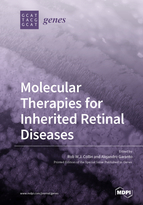Molecular Therapies for Inherited Retinal Diseases
A special issue of Genes (ISSN 2073-4425). This special issue belongs to the section "Human Genomics and Genetic Diseases".
Deadline for manuscript submissions: closed (1 March 2019) | Viewed by 78057
Special Issue Editors
Interests: gene augmentation therapy; inherited retinal diseases; optogenetics; Retinitis Pigmentosa; Stargardt disease; splicing modulation; vertebrate model systems
2. Department of Human Genetics and Radboud Institute for Molecular Life Sciences (RIMLS), Radboud University Medical Center, 6500 HB Nijmegen, The Netherlands
Interests: RNA editing; RNA delivery; genome editing; induced pluripotent stem cell technology; inherited retinal diseases; splicing modulation; molecular therapies; neurometabolic diseases; congenital disorders of glycosylation
Special Issue Information
Dear Colleagues,
Following the implementation of next-generation sequencing technologies (e.g., exome and genome sequencing) in molecular diagnostics, the majority of genetic defects underlying inherited retinal disease (IRD) can readily be identified. In parallel, the possibilities to counteract the molecular consequences of these defects are rapidly emerging, providing hope for personalized medicine. ‘Classical’ gene augmentation therapy has been under study for several genetic subtypes of IRD, and can be considered a safe and sometimes effective therapeutic strategy. The recent market approval of the first retinal gene augmentation therapy product (LuxturnaTM, for individuals with bi-allelic RPE65 mutations) by the FDA has not only demonstrated the potential of this specific approach, but also opens avenues for the development of other strategies. Yet, every gene—or even every mutation—may need a tailor-made therapeutic approach, in order to obtain the most efficacious strategy with minimal risks associated. Besides gene augmentation therapy, other subtypes of molecular therapy are currently being designed and/or implemented, including splice modulation, DNA or RNA editing, optogenetics and pharmacological modulation. In addition, the development of proper delivery vectors has gained strong attention, and should not be overlooked when designing and testing a novel therapeutic approach. In this Special Issue, we aim to describe the current state-of-the-art of molecular therapeutics for IRD, and discuss existing and novel therapeutic strategies, from idea to implementation, and from bench to bedside. This issue is not meant to include papers on therapeutic strategies for multifactorial eye diseases, such as age-related macular degeneration, glaucoma or myopia, nor on non-molecular therapeutics of IRDs such as cell replacement therapy or retinal implants.
Dr. Rob W.J. Collin
Dr. Alejandro Garanto
Guest Editors
Manuscript Submission Information
Manuscripts should be submitted online at www.mdpi.com by registering and logging in to this website. Once you are registered, click here to go to the submission form. Manuscripts can be submitted until the deadline. All submissions that pass pre-check are peer-reviewed. Accepted papers will be published continuously in the journal (as soon as accepted) and will be listed together on the special issue website. Research articles, review articles as well as short communications are invited. For planned papers, a title and short abstract (about 100 words) can be sent to the Editorial Office for announcement on this website.
Submitted manuscripts should not have been published previously, nor be under consideration for publication elsewhere (except conference proceedings papers). All manuscripts are thoroughly refereed through a single-blind peer-review process. A guide for authors and other relevant information for submission of manuscripts is available on the Instructions for Authors page. Genes is an international peer-reviewed open access monthly journal published by MDPI.
Please visit the Instructions for Authors page before submitting a manuscript. The Article Processing Charge (APC) for publication in this open access journal is 2600 CHF (Swiss Francs). Submitted papers should be well formatted and use good English. Authors may use MDPI's English editing service prior to publication or during author revisions.
Keywords
- Inherited retinal disease
- Molecular therapy
- Gene augmentation
- Splicing modulation
- Genome editing
- RNA editing
- Optogenetics
- Delivery vectors
- Retina








